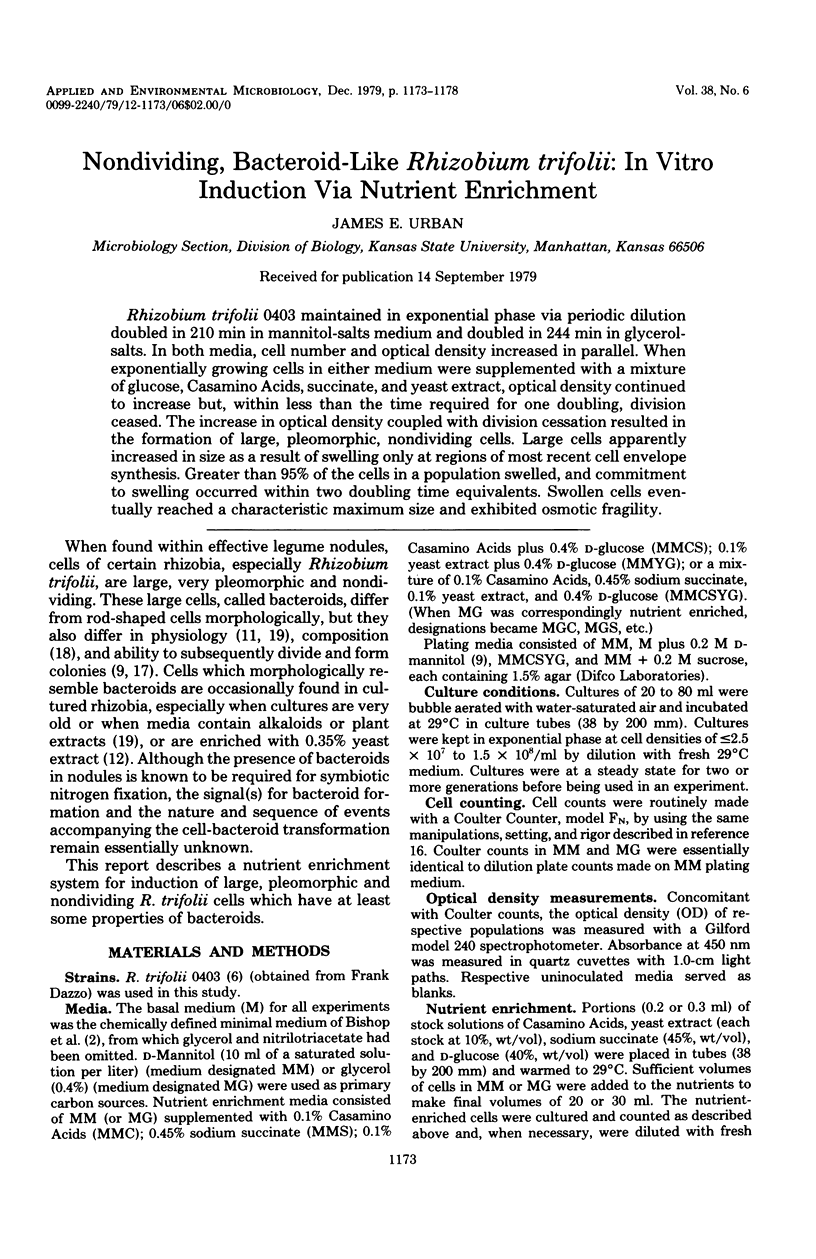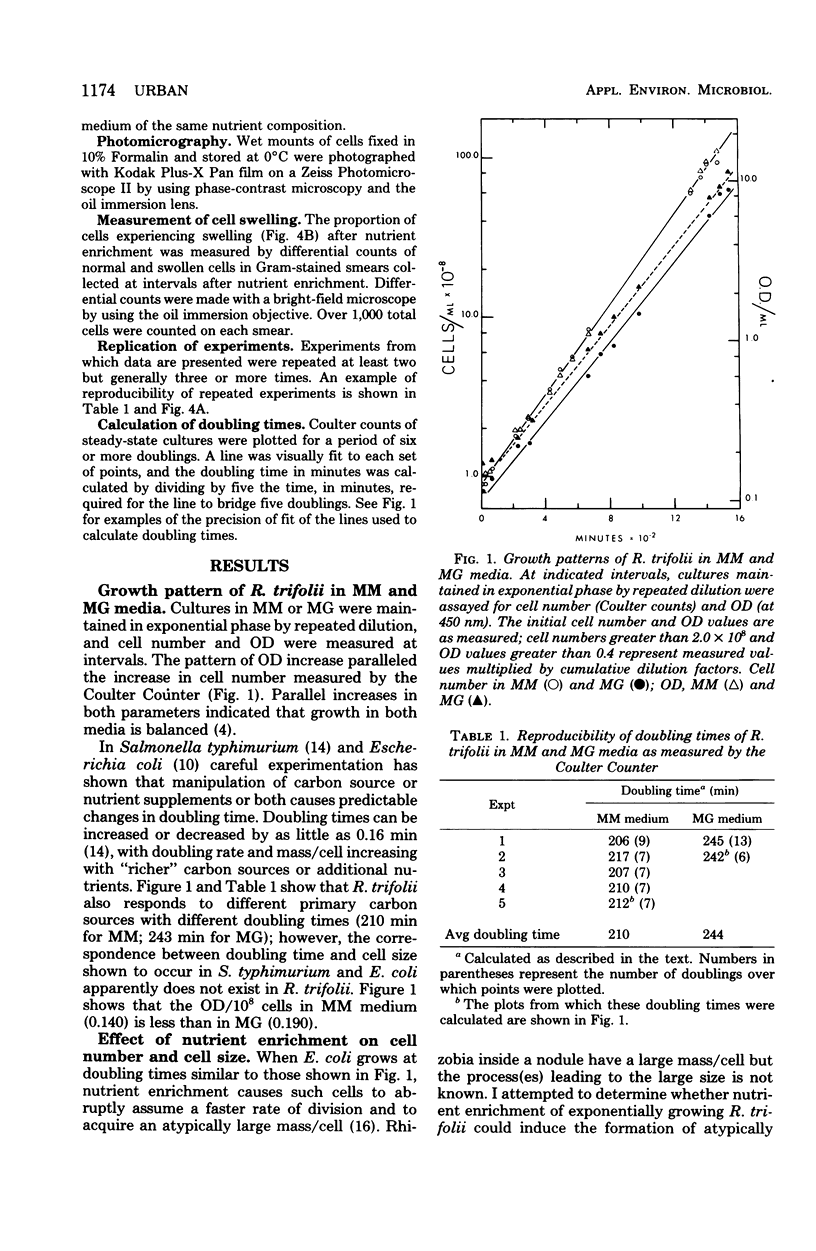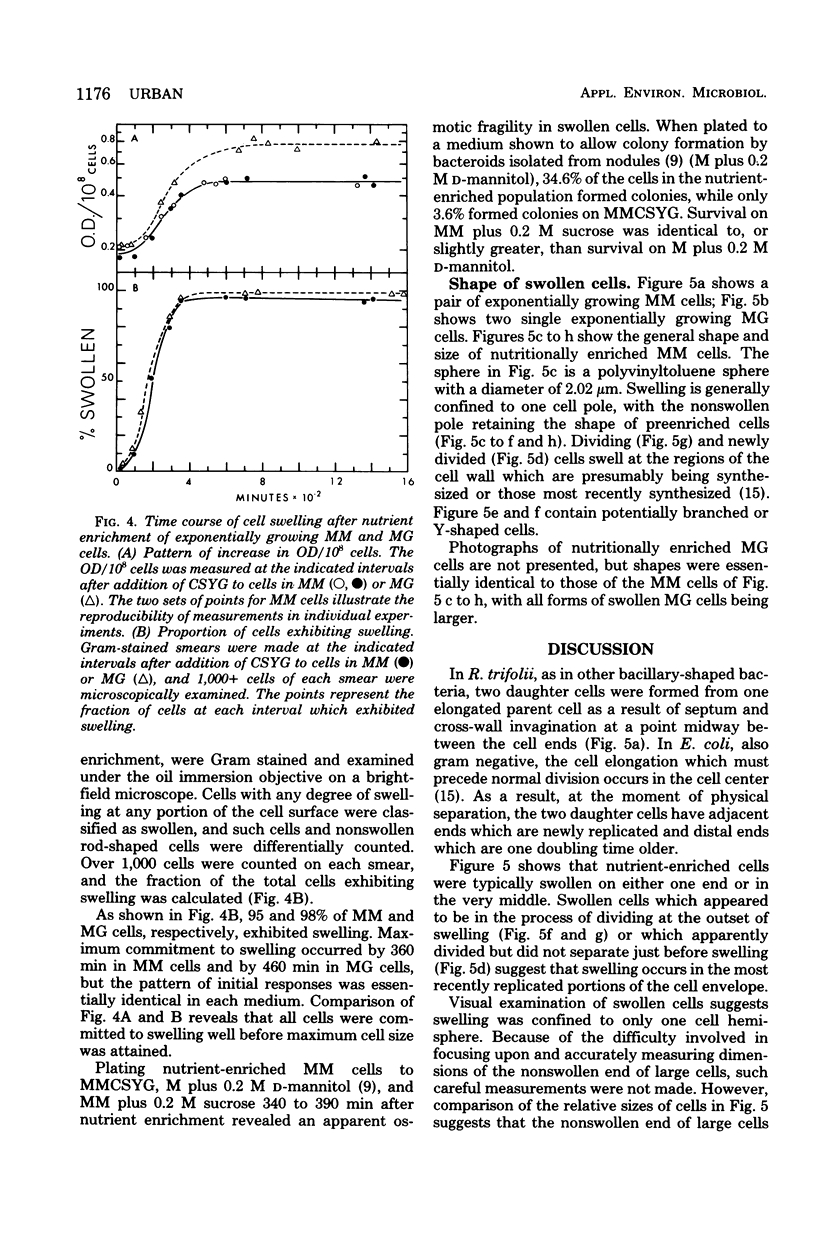Abstract
Rhizobium trifolii 0403 maintained in exponential phase via periodic dilution doubled in 210 min in mannitol-salts medium and doubled in 244 min in glycerolsalts. In both media, cell number and optical density increased in parallel. When exponentially growing cells in either medium were supplemented with a mixture of glucose, Casamino Acids, succinate, and yeast extract, optical density continued to increase but within less than the time required for one doubling, division ceased. The increase in optical density coupled with division cessation resulted in the formation of large, pleomorphic, nondividing cells. Large cells apparently increased in size as a result of swelling only at regions of most recent cell envelope synthesis. Greater than 95% of the cells in a population swelled, and commitment to swelling occurred within two doubling time equivalents. Swollen cells eventually reached a characteristic maximum size and exhibited osmotic fragility.
Full text
PDF





Images in this article
Selected References
These references are in PubMed. This may not be the complete list of references from this article.
- Bauer W. D. Lectins as determinants of specificity in legume-Rhizobium symbiosis. Basic Life Sci. 1977;9:283–297. doi: 10.1007/978-1-4684-0880-5_18. [DOI] [PubMed] [Google Scholar]
- Bishop P. E., Guevara J. G., Engelke J. A., Evans H. J. Relation between Glutamine Synthetase and Nitrogenase Activities in the Symbiotic Association between Rhizobium japonicum and Glycine max. Plant Physiol. 1976 Apr;57(4):542–546. doi: 10.1104/pp.57.4.542. [DOI] [PMC free article] [PubMed] [Google Scholar]
- Bohlool B. B., Schmidt E. L. Immunofluorescent polar tips of Rhizobium japonicum: possible site of attachment or lectin binding. J Bacteriol. 1976 Mar;125(3):1188–1194. doi: 10.1128/jb.125.3.1188-1194.1976. [DOI] [PMC free article] [PubMed] [Google Scholar]
- CAMPBELL A. Synchronization of cell division. Bacteriol Rev. 1957 Dec;21(4):263–272. doi: 10.1128/br.21.4.263-272.1957. [DOI] [PMC free article] [PubMed] [Google Scholar]
- Dazzo F. B., Brill W. J. Receptor site on clover and alfalfa roots for Rhizobium. Appl Environ Microbiol. 1977 Jan;33(1):132–136. doi: 10.1128/aem.33.1.132-136.1977. [DOI] [PMC free article] [PubMed] [Google Scholar]
- Dazzo F. B., Napoli C. A., Hubbell D. H. Adsorption of bacteria to roots as related to host specificity in the Rhizobium-clover symbiosis. Appl Environ Microbiol. 1976 Jul;32(1):166–171. doi: 10.1128/aem.32.1.166-171.1976. [DOI] [PMC free article] [PubMed] [Google Scholar]
- Helmstetter C. E. DNA synthesis during the division cycle of rapidly growing Escherichia coli B/r. J Mol Biol. 1968 Feb 14;31(3):507–518. doi: 10.1016/0022-2836(68)90424-5. [DOI] [PubMed] [Google Scholar]
- JORDAN D. C. The bacteroids of the genus Rhizobium. Bacteriol Rev. 1962 Jun;26:119–141. [PMC free article] [PubMed] [Google Scholar]
- Jordan D. C., Coulter W. H. On the cytology and synthetic capacities of natural and artificially produced bacteroids of Rhizobium leguminosarum. Can J Microbiol. 1965 Aug;11(4):709–720. doi: 10.1139/m65-094. [DOI] [PubMed] [Google Scholar]
- SAHLMAN K. AN ELECTRON MICROSCOPE STUDY OF ROOT-HAIR INFECTION BY RHIZOBIUM. J Gen Microbiol. 1963 Dec;33:425–427. doi: 10.1099/00221287-33-3-425. [DOI] [PubMed] [Google Scholar]
- SCHAECHTER M., MAALOE O., KJELDGAARD N. O. Dependency on medium and temperature of cell size and chemical composition during balanced grown of Salmonella typhimurium. J Gen Microbiol. 1958 Dec;19(3):592–606. doi: 10.1099/00221287-19-3-592. [DOI] [PubMed] [Google Scholar]
- Schwarz U., Ryter A., Rambach A., Hellio R., Hirota Y. Process of cellular division in Escherichia coli: differention of growth zones in the Sacculus. J Mol Biol. 1975 Nov 15;98(4):749–759. doi: 10.1016/s0022-2836(75)80008-8. [DOI] [PubMed] [Google Scholar]
- Sloan J. B., Urban J. E. Growth response of Escherichia coli to nutritional shift-up: immediate division stimulation in slow-growing cells. J Bacteriol. 1976 Oct;128(1):302–308. doi: 10.1128/jb.128.1.302-308.1976. [DOI] [PMC free article] [PubMed] [Google Scholar]
- Tsien H. C., Cain P. S., Schmidt E. L. Viability of Rhizobium bacteroids. Appl Environ Microbiol. 1977 Dec;34(6):854–856. doi: 10.1128/aem.34.6.854-856.1977. [DOI] [PMC free article] [PubMed] [Google Scholar]



